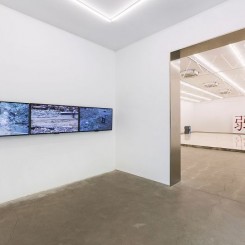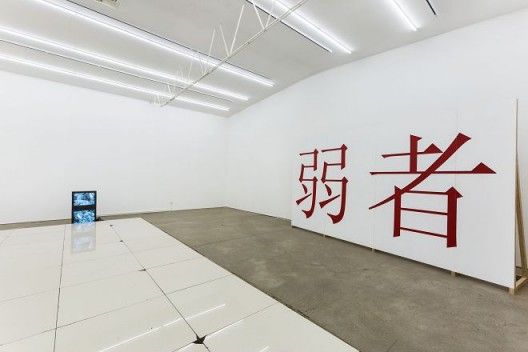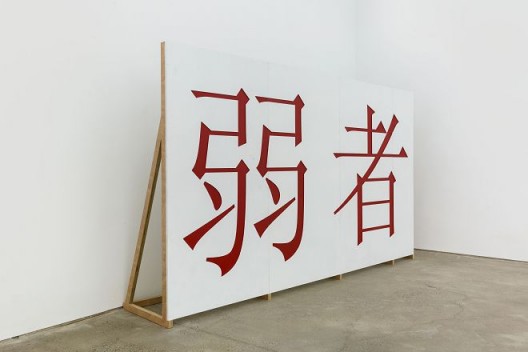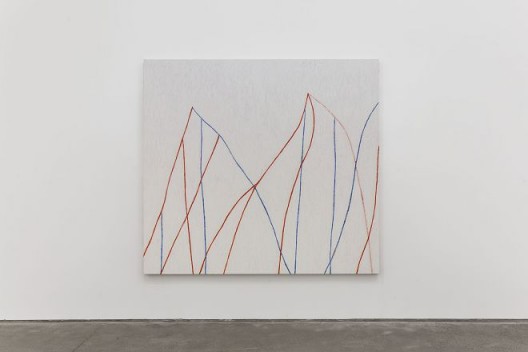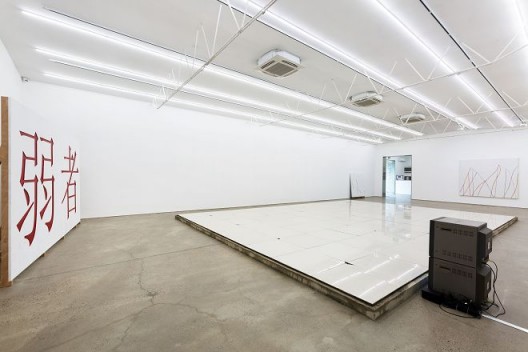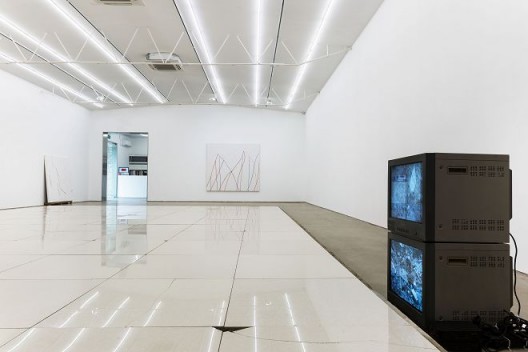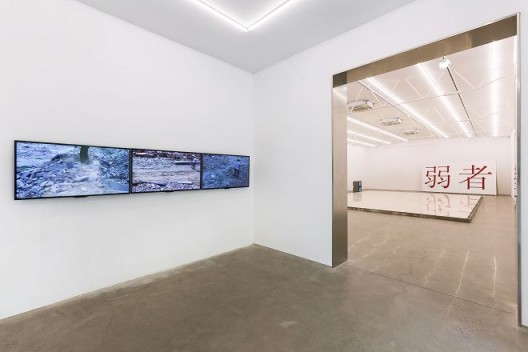The Weak
Stepping into the exhibition, what I first noticed were two Chinese characters about a person’s height, printed in red, jumping out from the white background of the gallery. These characters provide the most distinctive visual cues in Zeng Hong’s solo exhibition “Quaderni Rossi”. A work entitled The Weak forcefully announces its presence, and it reminded me of the various large typefaces found in public spaces across China. Yet this familiar image in my head forms an awkward contrast with the meaning of the words here, producing a kind of dissonance.
On the whole, The Weak can be called problematic. Its symbolism, its direct semantic intervention, as well as its strong visual effect set it apart from other works in the show, perhaps even contradicting the rest. As a personal project entirely initiated and executed by the artist, “Quaderni Rossi” is largely consistent with Zeng Hong’s artistic language and creative peculiarities—a restrained mode of presentation that approaches “degree zero” (in the Barthesian sense), with a vigilance against spectacular effects. Maintaining a balance between the conceptual and the aesthetic, his practice avoids being hijacked by any absolute rhetoric. Such defining characteristics not only permeate Zeng Hong’s non-figurative paintings; they are also reflected in his writings, interviews, and criticism.
For example, in the two paintings shown in “Quaderni Rossi”, Divided Lines (Green) and United Lines (Red and Blue), viewers could clearly make out the artist’s recent artistic style: on a near-white background, green lines are arranged sparsely and loosely; they form a stark contrast with the red and blue lines that intersect and extend from each other on the adjacent canvas, producing tensions between the lines’ movement and trajectory. Countless tiny brushstrokes are repeatedly stacked and superimposed in an almost monotonous manner, gradually allowing different forms to take shape and float on the canvas. As forms generate a variety of connections between each other, the final resulting lines and shapes have no recognizable images to be based on, nor do they have established connections with the real world. This slow, deconstructive process devoid of individual expressivity and narrative impulses annexes any surplus value more than the labor itself. The form itself is material, distancing itself from meaning, symbolism, and emotion, as the function of the latter is more relegated to text. As such, these instances make The Weak seem like an unharmonious rupture.
However, what this essay aims to discuss is precisely this rupture, and whether the “interference” it proved for the exhibition theme indeed disguised other facts. Let us first take this rupture as a starting point, and examine other parts of the exhibition—for example, we could compare Divided Lines (Green) and United Lines (Red and Blue) with other videos or installation works in the show—what is undeniable is that, among the different works, fundamental differences in aesthetics and approach are prevalent. If we disregard such differences, only The Weak’s inconsistencies trigger difficulties and questions of understanding: this implies that perhaps the problem does not lie with the work itself, but rather something outside of the exhibition space.
We will examine two videos in the show, The Stonecutters—A Sturdy Woman and A Skinny Woman, shot in 2015, and Key-Frame Extraction: Three Actions of An Old Man. Zeng Hong set the scene of laboring at the stone quarry as the main subject. Though these two videos are two variations on the same subject, they both present very specific environments, figures, and movements without too much editing. However, these works have already distanced themselves from the paintings depicting “two sets of lines”. What the former sought after was a direct and objective cut out from reality, locating the real at the surface of reality. The latter, on the other hand, uses pure color, lines, and shapes to illustrate another real logic related to art.
The question is, can the two co-exist in the same context as was presented? Does this unity not rely on the discursive logic of the main subject to take effect at the semantic level? In my mind, the two video works—their fixed point-of-view (as though the viewer is standing right behind the laborers), limited visual range (the viewer does not see more than what the laborers could see), the most simple and basic visual grammar (intentionally reducing editing and processing to guarantee that the scenery presented to the viewer is closest to reality)—both assumed the authentic portrayal of reality, as well as an empathetic approach. Is there truly an irreconcilable difference between this authentic reality and what The Weak points to?
The last work in “Quaderni Rossi” is an installation entitled Unease. It pushes the idea of “authentic reality” to a culminating point. The work consists of a concrete platform raised above the ground at the center of the exhibition space, occupying about half of the floor space. The surface of the platform is covered with old ceramic tiles that the artist collected from the outskirts. As Zeng Hong instructed the installation workers to line the tiles according to the conventions of interior decoration that they are normally used to, it made Unease look every bit as the interior flooring common throughout cities and rural areas in China. Anywhere outside of the gallery, it would merely be a most ordinary tiled floor. If painting or video could maintain its relative independence by virtue of form, then on this ceramic tile floor, we cannot find anything that could distinguish it from the turbidity of life and the mundaneness of everyday objects. But this ceramic-tile floor injects an air of liveliness into the exhibition space. Its silent presence is akin to the ruins of a temple, bringing a sense of nobility to those forgotten by history, as well as the commonplace, invisible, “lowly labor” (diduan laodong) contributed by the latter. However, the structure and combination of concrete and ceramic tiles are by no means monopolized by art. Simply put, they are but a basic part of everyday language. There are no fundamental differences between the tiled floor and the two Chinese characters in terms of the way they are presented here, the way they have been inserted into the exhibition space.
Perhaps this floor can allow us to begin thinking about the real problem revealed by The Weak. Interestingly, these two characters are not really floating in space. In fact, indented shapes are first carved onto a board, then the board itself and the indented shapes are painted different colors. Such seemingly excessive procedures force the words from the flat and the abstract into the real and the substantial, hovering somewhere between three-dimensional structure and two-dimensional imagery. The Weak is both text and installation. Though it originates from the conceptual realm, it relies on a specific object anchored in the real world to manifest itself. However, we tend to neglect the potentials of language and text: why shouldn’t the latter manifest as a physical existence? If text can simultaneously be imagery, like the avant-garde experiments in the twentieth century, could they also exist as objects? It then begs the question, could objects be text at the same time? Just like the way that planes, lines, and shapes found in Zeng Hong’s paintings, which seemingly have no counterparts in reality, could be understood as substantial, sculptural forms, this kind of substantiality, in the artist’s own words, is specific and real. Conversely, “abstract painting” purely based on form risk devolving into “toys of the bourgeoisie.” (1) In the paintings depicting “two sets of lines”, lines that disperse or converge result not from a purposeful layout or an effect-driven impulse, but rather a specific generative process. In these red, green, and blue lines, we can distinguish even more miniscule lines, which extend the former into uneven entities. Constructing everything on a repetitive, utterly fundamental process of labor that verges on “degree zero”, the artist returns to the worker; in making no attempt to disguise the traces of labor; Zeng Hong’s painting draws a line between the myth of creativity and the nature of work itself. In the exhibition preface to “Quaderni Rossi”, Zeng Hong re-evaluates the work of Courbet: “When Gustave Courbet consciously revealed his radical political position in his figurative paintings, he adopted the approach of painting directly onto the canvas in depicting the common labors and realist life scenes…The realist painting that he established allowed form and content to align with each other.” In another interview, Zeng mentioned that in his paintings, he regarded planes, lines, and shapes as forms that could be shaped and sculpted, not merely abstract elements that constituted form. It was a way to keep non-figurative paintings connected to reality. (2) And it is this link to reality that fundamentally kept the paintings, videos, and installations in the show together, in that they all shared a universal ideal. Both Courbet and Rodchenko shared and explored this ideal during different historical periods. And under new contexts and threads of meaning, it attempts to reach a possible agreement between art, the mundane, and life itself.
“Over the past decade, art and architecture have been transformed from producers of illusions into receptacles for illusions…They concentrate all their attention of appearance and superficiality and are translated into a cultural phenomenon whose reality remains hidden behind the ‘theatrical’…No longer concerned with the portrayal of illusions and visual and environmental artifice, art and architecture have become illusions and artifice,” Germano Celant writes heavy-heartedly at the opening of A Visual Machine Art Installation and Its Modern Archetypes. Under the control of a cultural economics dominated by “self-display”, art has no choice but to pit self-representation as the subject of display. “Concrete monistic perceptions of the world and its activities”— a real logic anchored in reality—is instead shut out of the sealed-off theater of illusions. (3) However, Celant’s essay also provided a solution, instructing us to look for answers in the succession of history. Among the criticism and exhibitions of the 1920s, there were already numerous examples that aligned art with other cultural and political practices, thereby affirming the concordance between aesthetics and political ideologies. “This method has the merit of exhibiting not merely objects, but the connections among various cultural processes as well as their political implications. Everything is thus reduced to a document of its time…Connotations of quality disappear and hierarchical differences are destroyed.” (4) Today, we can return from early 20th century discourses and attitudes, and wrestle art away from the control of established systems and capital back to the level of reality, once more opening up to the care of religion and ethics. In this order anchored in reality, art seeks to foretell an integral world through connections between words, image, and objects.
This explains the issue with The Weak. To some extent, it is in fact a problem derived from the cultural order and hierarchical system in which we find ourselves. In 2013, Jacques Rancière
gave a lecture entitled “What is the Time of Contemporary Art” during his visit to China. He proposed that we still need to rethink spatiality, visuality, and language through the perspective of “contemporary art” as conceived by Tatlin’s time. In that period, artists attempted to restore text, image, and movement back to the same reality. Once, art was viewed as the creation of new perceptive realms, and it is precisely this aim which is abandoned by today’s art. (5) In today’s exhibition culture and discursive realm, the present state of art is isolated from its past. Therefore, it is hard to understand a foreign presence such as the “The Weak”, which is by laid bare, without mediation and representation. As the latter’s entry is an external event, it could no longer be effectively digested by the internal logic of contemporary exhibitions. To respond to the question posed by The Weak towards “contemporary art” today, we need to redefine our practices within the narrative of history and the real as a whole. “Quaderni Rossi” is undoubtedly such an attempt, as it returned all (autonomist) autonomy back to the artist. Faced with a reality in which art production, dominated by institutions, is characterized by standardization, division of labor, and outsourcing, every step of this exhibition was executed independently by the artist, from production, preparation, to exhibition and discursive content, even including the poster design and press release. The title “Quaderni Rossi” is taken from an eponymous political journal published during the Italian Autonomist worker movements in the 1960s; even the poster design is also a variation of the journal’s publication cover. At one point, the journal had a profound impact on the worker’s movement in Italy and indeed Europe, demanding for worker a wider form of autonomous and democratic organization—a new freedom of congregation. The certainty of this political language again stated how that which lies behind art is the real. Apart from the artist’s labor, this was what jelled in the exhibition.
(1) Excerpt from the conversation between Zeng Hong and Xiang Jing, 2015. For the full text, see http://qn.res.dome.me/Storage//6066L02X/Pdf/2017/3/f3c4abb3-1703-4ef1-a147-0950d5c1c6d1.pdf
(2) Ibid.
(3) Excerpt from Visual Machine—Art Installation and its Modern Archetypes, Germano Celant, translated by Du Yu, The Visual Subconscious (Tianjin: Publishing House of Tianjin Academy of Social Sciences, 2002)
(4) Ibid.
(5) Excerpt from “What is the Time of Contemporary Art”, lecture by Jacques Rancières (UCCA, 2013, May 12)
